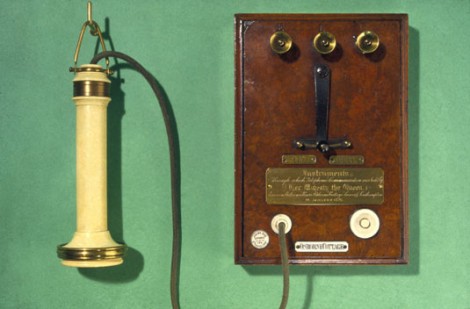
“The Americans have need of the telephone, but we do not. We have
plenty of messenger boys.” – Sir William Preece, Chief Engineer, British Post Office, 1878
“This telephone has too many shortcomings to be considered as a means of communication. The device is of inherently no value to us.” – Western Union internal memo, 1876
“Getting a new idea adopted, even when it has obvious advantages, is often very difficult.” – Rogers, 1962
Adoption of technology by end users is key to its success – even the most brilliant innovation is worth nothing if it doesn’t get used. Many technologies suffer from delays in achieving adoption. For example, voicemail was reported to have taken roughly 10 years to achieve widespread adoption [1], while the fax machine took roughly 50 years [2]. This shows that it is not just quality or usefulness that determines successful adoption: there are other factors at work.
Back in the late 1800s, the telephone met considerable resistance – people just didn’t get it. Bell actually tried to sell the patent to Western Union and to the British Post Office, but neither were in the slightest bit interested. The chief engineer at the British Post Office famously replied that they didn’t need it because “We have plenty of messenger boys.” [3]. This shortsightedness was the best thing that could have happened to Bell – today, the patent is regarded by some as one of the most profitable patents ever created [4].
Once Bell decided to start a telecoms business, the tricky business of adoption had to be dealt with. Bell knew that the benefits of the telephone were undeniable once experienced in the real world, or once you saw others like you experiencing it (aka observational learning). So, Bell Co. put telephones in hotel rooms for calling the front desk, in offices as a replacement to intercoms, and near lunch counters in diners and lunch rooms – “…that way, it reasoned, people who didn’t know how to use them would be likely to see people who did know how and in this way learn about the phone system.” [5]
By positioning telephones by lunch counters, Bell Co. are likely to have considered the public availability of the telephone usage, the highly concentrated flow of people past the telephone as they queued to buy their food, and the stage-like nature of this arrangement. They also indirectly chose a time for the interaction – lunch break, when many people have time to kill. Pretty clever when you think about it. Plus, the idea of replacing office intercoms with telephones was inspired. Intercoms were already used widely – by swapping in a telephone, this familiarized people with phones, using a known, comfortable context. Intercom-style usage is very limited (single point to single point, with no network), but it served well as a “foot in the door” to capture the attention of potential users.
What does all this mean for you – the designers of tomorrow’s products? Well, one thing’s for sure. Designing your product is only half the battle. If your product really is as disruptive as you think it is, you have to design a strategy for adoption.
References:
[1] Fancik, E., Rudman, S. E., Cooper, D., & Levine, S. (1991). Putting innovation to work: adoption strategies for multimedia communication systems Commun. ACM 34 (12), 52-63.
[2] O’Brien, L. (1989). Will the fax boom go bust? Telephony, 217(14), 38-46.
[3] Cosier, G., & Hughes, P. M. (2001). The Problem with Disruption. BT Technology, 19(4), 9.
[4] The Telephone Patent Follies on telecomhistory.org
[5] Brown, J. S., & Duguid, P. (2000). The Social Life of Information. Boston, Mass.: Harvard Business School; New York : McGraw-Hill.
Image credit: Early Bell telephone and terminal panel, 1877. The Science Museum
The Bell Co. telephone adoption story can be found in The Social Life of Information by John Seely-Brown and Paul Duguid. Many thanks to Aaron Cheang who reminded me of this story while we were chatting about Google Wave.
Nice post. Poor old British Post Office, although they did eventually catch on to the significance of the telephone. Sadly they seem to have been completely wrong-footed by the internet.
Nice post. Glad our discussions stimulate your blogs!
Let’s see if Google Wave can be a disruptive technology or not
A great slide deck for how to approach adaptation can be seen at http://www.slideshare.net/bokardo/designing-for-social-traction
Thanks for a stimulating post Harry. Interesting quote from the Post Office. Reminds me of the argument that the Ancient Romans could have had the Industrial Revolution 2,000 years early if they hadn’t been so wedded to a slave economy.
On the flipside, is the danger here that we have the old arrogant technologist’s fallacy that ‘people will want it when we explain to them what it does’? The great masses are disruptive in their usage of technology, as much as the technology itself disrupts. British Telecom for example conceived SMS as a business tool, yet it was adopted by kids who owned phones but couldn’t afford extortionate call charges.
I wonder how much of the telephone’s common uses were actually predicted by Bell?
I like your last point – designing the product is only half the battle, you need an adoption plan too.
Telephones, voicemail, fax, SMS and (I think) Google Wave are all platform products. Their point is to enable other people to do other things using the platform, and, nobody is smart enough to predict all the things other people will do (or be willing to pay for) on a platform once it’s out there.
Of course, this makes planning for adoption a lot higher risk.
But, if you win with a platform, you tend to win BIG.
You could even state that revolutionary disruptive technologies must be met with sceptic, if not, they are not revolutionary
Pingback: Top posts of 2009 on 90percentofeverything.com- 90 Percent of Everything
Pingback: What’s wrong with a little learning curve?
Pingback: Our Bookmarks: Oct 12 - Oct 18, 2009